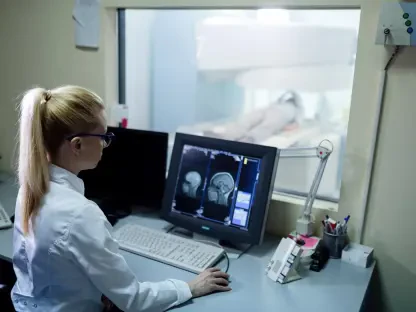Imagine a world where a doctor can foresee a life-threatening condition like a heart attack or cancer a full decade before any symptoms emerge, allowing for interventions that could save countless lives and transform the future of medicine. This is no longer a distant dream but a tangible reality brought forth by cutting-edge Artificial Intelligence (AI) technology. Developed by scientists in Germany and Denmark, this predictive AI model is revolutionizing the healthcare landscape by analyzing vast datasets to forecast serious diseases with unprecedented accuracy. This review delves into the intricacies of this transformative tool, exploring its capabilities, real-world impact, and the challenges it faces in reshaping preventive care.
Unveiling the Power of Predictive AI in Medicine
At the heart of this technological breakthrough lies the ability of AI to sift through enormous amounts of health data, transforming raw information into actionable insights. Trained on records from 400,000 Britons and validated with data from 1.9 million Danes, the model operates much like a language-learning algorithm, but instead of words, it deciphers patterns in patient histories, diagnoses, and lifestyle factors such as smoking. This capacity to predict diseases like heart attacks, cancer, and sepsis up to 10 years in advance positions AI as a cornerstone of modern medical innovation.
The significance of this technology extends beyond mere prediction; it represents a fundamental shift toward proactive healthcare. By identifying at-risk individuals long before traditional diagnostic methods would, the system empowers clinicians to prioritize prevention over reaction. This approach not only promises to improve patient outcomes but also aims to alleviate the financial burden on healthcare systems by reducing the need for costly emergency treatments.
Technical Insights into the AI Model’s Functionality
Mastering Data Analysis for Health Forecasting
A key strength of this AI model is its sophisticated approach to data analysis and pattern recognition. By meticulously examining medical records, test results, and behavioral data, the system uncovers subtle correlations that might elude human observation. This intricate process enables the identification of early warning signs for conditions that often develop silently over years, providing a critical window for intervention.
Beyond simple detection, the model’s ability to handle diverse datasets across different populations underscores its adaptability. Its training and validation across two distinct healthcare systems demonstrate a robustness that is essential for scaling such technology globally. This analytical prowess ensures that predictions are not mere guesses but are grounded in comprehensive, evidence-based insights.
Simulating Health Trajectories for Better Planning
Another remarkable feature is the AI’s capacity to simulate potential health outcomes over extended periods. For conditions with predictable progression, such as cardiovascular diseases and specific cancers, the model offers long-term risk assessments that guide clinical decision-making. This simulation capability allows doctors to tailor preventive strategies to individual patients, enhancing the precision of care.
Additionally, the technology can generate artificial patient data for research purposes, particularly in scenarios where real-world information is scarce. This functionality proves invaluable for studying rare conditions or testing hypothetical interventions, bridging gaps in medical knowledge. Such simulations pave the way for innovative approaches to disease management, even in under-researched areas.
Real-World Impact on Healthcare Delivery
The practical applications of this AI model are already making waves in the realm of preventive medicine. By forecasting serious health risks well in advance, it enables healthcare providers to implement early interventions that can alter disease trajectories. For instance, identifying a high risk of heart attack years ahead allows for lifestyle modifications or medical treatments that could prevent the event altogether.
Moreover, the technology supports cost reduction in healthcare by minimizing the need for acute care. Hospitals and clinics can allocate resources more efficiently, focusing on prevention rather than last-minute, high-cost treatments. This shift not only benefits patients but also strengthens the sustainability of healthcare systems grappling with rising expenses.
A notable aspect of its deployment is the successful integration across varied medical frameworks, showcasing its versatility. The model’s ability to adapt to different protocols and patient demographics highlights its potential for widespread adoption, provided ongoing refinements address existing limitations. This adaptability is a crucial step toward making preventive care a universal standard.
Navigating the Challenges and Limitations
Despite its impressive capabilities, the AI model faces significant hurdles that must be addressed for broader efficacy. One prominent limitation is its reduced accuracy in predicting less predictable conditions, such as mental health disorders or complications during pregnancy. These areas require further research to enhance the model’s scope and reliability.
Another concern is the demographic focus of current testing, which primarily includes individuals aged 40 to 60. The lack of data on younger populations and diverse ethnic groups raises questions about the generalizability of predictions. Without inclusive datasets, the risk of biased outcomes looms large, potentially undermining the technology’s credibility.
Efforts are underway to expand testing and incorporate more varied data, a critical step for ensuring equitable healthcare solutions. Addressing these gaps will be essential for the model to serve a global population effectively. Until then, its application remains somewhat constrained, necessitating cautious optimism about its immediate impact.
Looking Ahead: The Future of AI in Preventive Care
The potential for AI-driven disease prediction to transform healthcare is immense, with prospects for refinement and expansion on the horizon. As research progresses from this year onward, enhancements in data diversity and algorithmic precision are expected to broaden the model’s applicability. This evolution could usher in an era of truly personalized medicine tailored to individual risk profiles.
Global adoption remains a key goal, contingent on overcoming current barriers related to data inclusivity and accuracy. If successful, this technology could redefine preventive healthcare, making early intervention a norm rather than an exception. The focus over the next few years, particularly through strategic collaborations, will likely center on scaling these solutions to underserved regions.
Moreover, integrating AI with other emerging technologies, such as wearable health devices, could further amplify its impact. Such synergies might enable real-time risk monitoring, providing continuous updates to both patients and providers. This forward-looking vision underscores the dynamic role AI could play in shaping the future of medical care.
Reflecting on a Milestone in Medical Technology
Looking back, the development and initial deployment of this AI disease prediction model marked a pivotal moment in healthcare innovation. Its ability to anticipate serious conditions with remarkable foresight offered a glimpse into a future where prevention took precedence over cure. The technology’s performance across different systems highlighted its potential as a universal tool for enhancing patient outcomes.
The journey, however, revealed clear areas for improvement, from demographic representation to predictive accuracy for complex conditions. The path forward demanded a concerted effort to refine data inputs and expand testing protocols. Stakeholders were encouraged to prioritize inclusivity, ensuring that no population was left behind in the quest for better health.
As a next step, investment in cross-disciplinary research and international partnerships emerged as a vital strategy. Collaborations between technologists, medical professionals, and policymakers could accelerate the model’s evolution, addressing ethical and practical challenges. This collective approach promised to solidify AI’s role in preventive care, turning early predictions into actionable, life-saving measures for generations to come.









